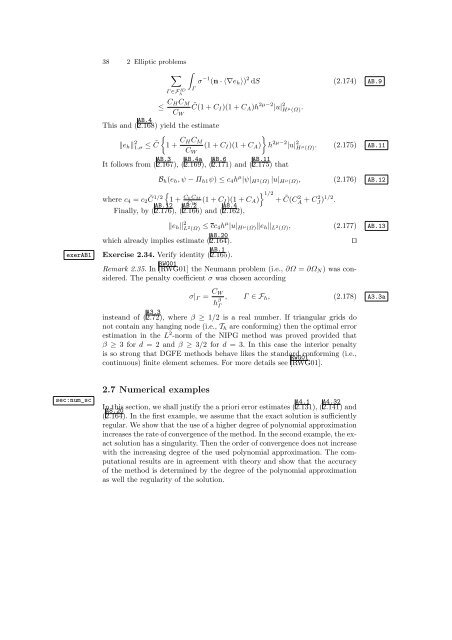2 DGM for elliptic problems
2 DGM for elliptic problems
2 DGM for elliptic problems
Create successful ePaper yourself
Turn your PDF publications into a flip-book with our unique Google optimized e-Paper software.
38 2 Elliptic <strong>problems</strong><br />
∑<br />
∫<br />
Γ ∈F ID<br />
h<br />
Γ<br />
σ −1 (n · 〈∇e h 〉) 2 dS (2.174) AB.9<br />
≤ C HC M<br />
C W<br />
˜C(1 + CI )(1 + C A )h 2µ−2 |u| 2 H µ (Ω) .<br />
This and ( 2.168) AB.4 yield the estimate<br />
{<br />
‖e h ‖ 2 1,σ ≤ ˜C 1 + C }<br />
HC M<br />
(1 + C I )(1 + C A ) h 2µ−2 |u| 2 H<br />
C (Ω). W<br />
(2.175) AB.11<br />
It follows from ( AB.3 2.167), ( AB.4a 2.169), ( AB.6 2.171) and ( AB.11 2.175) that<br />
B h (e h ,ψ − Π h1 ψ) ≤ c 4 h µ |ψ| H 2 (Ω) |u| H µ (Ω), (2.176) AB.12<br />
{<br />
1/2<br />
where c 4 = c ˜C1/2 2 1 + C hC M<br />
C W<br />
(1 + C I )(1 + C A )}<br />
+<br />
2 ˜C(C A + CJ 2)1/2 .<br />
Finally, by ( 2.176), AB.12 ( 2.166) AB.2 and ( 2.162),<br />
A8.4<br />
exerAB1<br />
‖e h ‖ 2 L 2 (Ω) ≤ cc 4h µ |u| H µ (Ω)‖e h ‖ L 2 (Ω), (2.177) AB.13<br />
which already implies estimate ( 2.164). A8.20<br />
⊓⊔<br />
Exercise 2.34. Verify identity ( AB.1 2.165).<br />
Remark 2.35. In RWG01 [RWG01] the Neumann problem (i.e., ∂Ω = ∂Ω N ) was considered.<br />
The penalty coefficient σ was chosen according<br />
σ| Γ = C W<br />
h β , Γ ∈ F h , (2.178) A3.3a<br />
Γ<br />
insteand of ( 2.72), A3.3 where β ≥ 1/2 is a real number. If triangular grids do<br />
not contain any hanging node (i.e., T h are con<strong>for</strong>ming) then the optimal error<br />
estimation in the L 2 -norm of the NIPG method was proved provided that<br />
β ≥ 3 <strong>for</strong> d = 2 and β ≥ 3/2 <strong>for</strong> d = 3. In this case the interior penalty<br />
is so strong that DGFE methods behave likes the standard con<strong>for</strong>ming (i.e.,<br />
continuous) finite element schemes. For more details see [RWG01].<br />
RWG01<br />
sec:num_sc<br />
2.7 Numerical examples<br />
In this section, we shall justify the a priori error estimates ( 2.131), A4.1 ( 2.141) A4.32 and<br />
( 2.164). A8.20 In the first example, we assume that the exact solution is sufficiently<br />
regular. We show that the use of a higher degree of polynomial approximation<br />
increases the rate of convergence of the method. In the second example, the exact<br />
solution has a singularity. Then the order of convergence does not increase<br />
with the increasing degree of the used polynomial approximation. The computational<br />
results are in agreement with theory and show that the accuracy<br />
of the method is determined by the degree of the polynomial approximation<br />
as well the regularity of the solution.
















